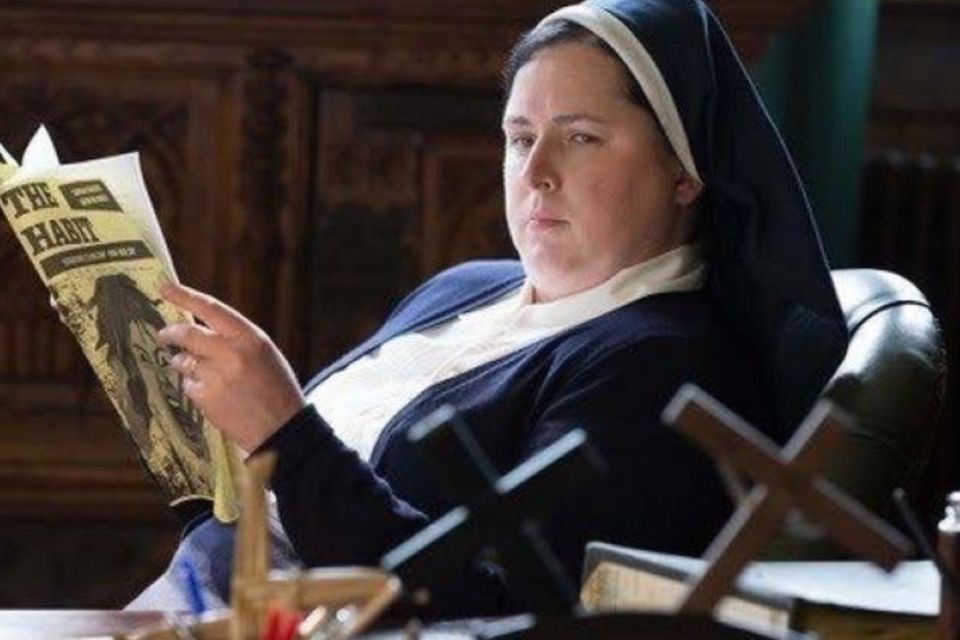The Netflix show Derry Girls has been on my mind a lot during this stomach-churning election season. I’ll try to explain why.
Set in Derry, Northern Ireland, in the mid-1990s, the show follows four teenage girls (and a cousin, James) against the backdrop of The Troubles, the violent conflict that kept the region in a tense military state since the late 1960s. If you’re not in the mood for a story about partisan political violence, stay with me. Because the show isn’t about politics in the traditional sense.
“It’s fair to say I have a somewhat complicated relationship with my home town,” says Erin Quinn, the show’s sixteen-year-old protagonist. “The thing about living in Derry is, there’s nowhere to hide. Everybody knows everybody, knows everything about everybody, and sometimes all I really want is to be simply left alone.”
In this clever cut, we see that it’s actually her cousin Orla, reading from Erin’s diary. Erin is enraged, and their first conflict is off and running.
The show is quirky, hilarious, wonderfully written and acted, at once irreverent and tender toward its characters. But all of that isn’t why it fascinates me.
What’s most striking about the teens and their families is how oblivious they are, most of the time, to the world-historic events unfolding around them. When a newscaster reports a bomb threat shutting down a bridge, Orla’s mother complains it’s going to make her late for her tanning appointment. When British troops board the girl’s school bus at a security checkpoint, the boy-crazy Michelle remarks, “Some of them are rides. I’m willing to admit it even if no one else will.” (A “ride” is a hottie, if it isn’t clear from context. If by chance you aren’t up on the slang of mid-90s Northern Ireland, go ahead and turn on the subtitles—it helps!)

The concerns of the girls are exams, crushes, talent shows, sneaking alcohol and breaking curfew, and staying out of trouble from their parents and their acid-tongued headmistress, Sister Michael. The show plays their short-sighted perspective for laughs. They’re adolescents, after all. Their parents and grandparents, too, are caught up in mundane domestic dramas. We get a sense of their cramped, cluttered lives in a Catholic neighborhood—shared bedrooms, overflowing counter tops, laundry-folding on the kitchen table while dinner simmers on the stove.
Writer and creator Lisa McGee says she created the show because she couldn’t recognize her hometown of Derry in any existing film depictions. They were all too humorless. “There were never any jokes,” she told The New Yorker. “I don’t know any Northern Irish person that isn’t funny.”
Somehow, that seems important. By poking fun at mundane private lives, the show makes a powerful commentary on what politics is ultimately for. The point is not to live in a state of perpetual partisan battle, but to provide a foundation of stability and justice on which we can live our lives. The work of seeking justice and maintaining democracy is never finished, of course. Our civic duty is never finished. “And liberty and justice for all” will always be more prayer and longing than a lived reality.
But Derry Girls offers a perspective I find lacking in our dominant cultural discourse, not just in this election season but for years now. One of the countless ways Donald Trump has damaged our country is to make politics all-totalizing. He needs a state of constant crisis and fear to manipulate attention. But the rest of us don’t need that.
By showing the beauty and hilarity in the ordinary, Derry Girls has been a life-giving breath in anxious times. It doesn’t hurt that the soundtrack leans heavily on 90s nostalgia, particularly the reverberating guitars and aching-haunting vocals of The Cranberries.
One last note. Derry Girls knows how to stick its landings—each of the three season finales is a banger. In the final one, the timeline leaps forward a year to the run-up to the Good Friday Agreement, the 1998 referendum that sought to end three decades of violence through a complex set of resolutions, including the release of paramilitary prisoners.
One of those is Michelle’s older brother, who has been imprisoned for the entirety of the show. Erin’s sense of fairness bristles at the possibility of convicted killers like him walking free. When Michelle tells her, “These things, they’re not black-and-white,” she responds:
“Aren’t they?”
“Nothing about this place is.”
“Well, I think the fact that you shouldn’t kill people is pretty black-and-white.
Erin is already angry that her 18th birthday party coincides with the vote. Due a tangled series of compromises, her party has the mashup theme of Literary Greats and Monkeys (long story) and also shares a reception hall with a First Communion party, so Erin sits down glumly with a group of seven-year-olds in poofy dresses.
The absurdly layered context sets the stage for Erin’s moment of growth. As she contemplates her vote, she takes in the “wee uns” around her—the first time we see her fully aware of lives outside her age bubble. It allows her to rise above a faulty notion of “fairness” and grasp the bigger opportunity of a historic vote for peace.

It’s a beautiful image of growing up—a change of consciousness skillfully rendered. And yet all the immaturity she and her friends show along the way is just as delightful. In the climactic scene, a succession of characters steps into the voting booth, their faces filled with fear and hope. It’s not just capital “D” democracy they’re affirming, but all the small ordinary moments that give shape to their lives.
That’s worth fighting for.


3 Responses
Exactly what I needed to read this week. (And now, maybe, rewatch)
This is a wonderful prospective. I hope and pray for Tuesday.
Thanks for the reminder on the broader perspective, and bringing this very well crafted series to the attention of others.